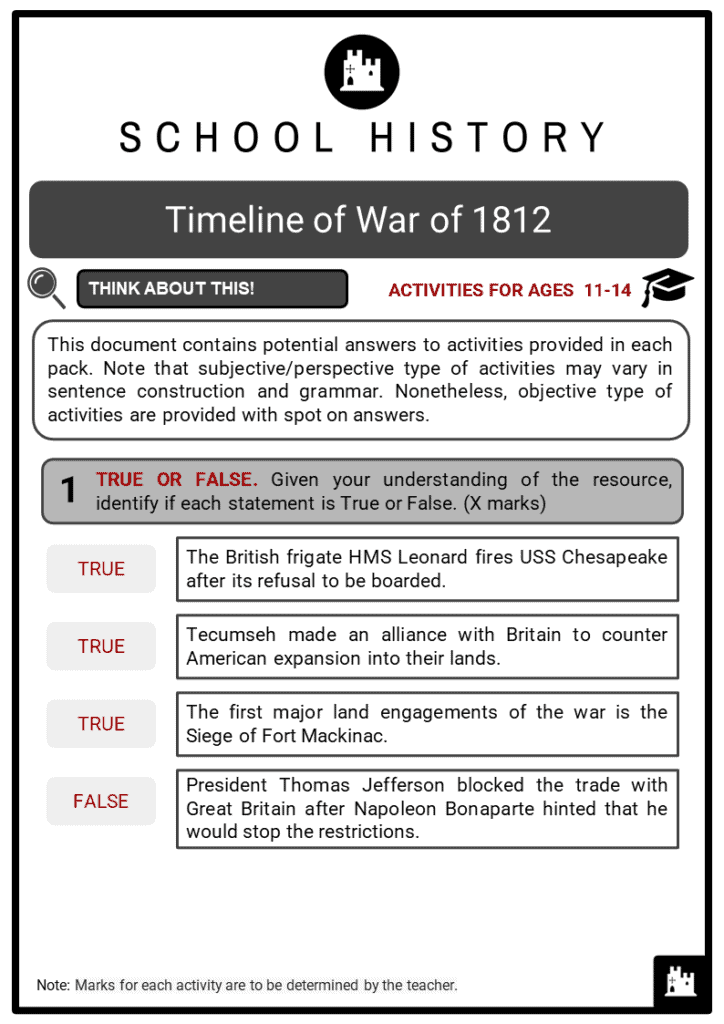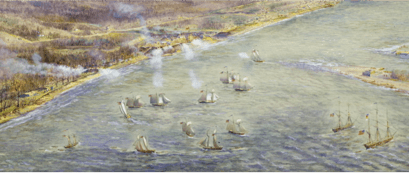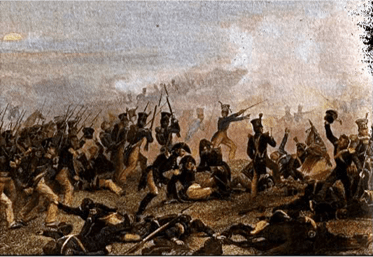Download Timeline of War of 1812 Worksheets
Do you want to save dozens of hours in time? Get your evenings and weekends back? Be able to teach Timeline of War of 1812 to your students?
Our worksheet bundle includes a fact file and printable worksheets and student activities. Perfect for both the classroom and homeschooling!
Table of Contents
Add a header to begin generating the table of contents
Summary
- Background of the War of 1812
- Chronological order of events during the War of 1812
- Key figures involved in the War of 1812
Key Facts And Information
Let’s find out more about the Timeline of War of 1812!
- The War of 1812 was conflict between the United States and Great Britain on June 1812 to February 1815 over British violations of U.S. maritime rights. During the war, United States took over the greatest naval power at the time.
- The tensions of the war started from the French revolution and Napoleonic Wars. During this conflict between France and Britain, American interests were blocked as the two countries’ endeavours restricted the U.S. from trading.
- In 1807, Great Britain passed the Orders in Council – requiring neutral countries to get a license from the authorities before trading with France or the French colonies. The Royal navy outraged the Americans by the practice of impressment of the American seamen and America’s desire to expand its territory.
- In 1809, the U.S. Congress repealed the Embargo Act of Thomas Jefferson, nonviolent resistance to British and French molestation of U.S. merchant ships carrying war materials and other cargo to European belligerents during the Napoleonic Wars. The Non-Intercourse Act, that replaced the said act, prohibited trade with Britain and France.
- President James Madison blocked the trade with Great Britain after Napoleon Bonaparte hinted that he would stop the restrictions. The new members of Congress led by Henry Clay and John Calhoun had begun to agitate for war, according to their indignation over British violations of maritime rights and Britain’s encouragement of Native American hostility against American westward expansion.
- JULY 23, 1805
- In the USS Essex incident, the British justify the seizure of trading ships travelling between neutral and enemy ports.
- OCTOBER 21, 1805
- The Franco-Spanish fleet was defeated by the Royal Navy at the Battle of Trafalgar, preventing Napoleon’s Invasion of the Great Britain.
- JANUARY 25, 1806
- Congressman James Madison reports to Congress on matters concerning British interference and impressment of Americans.
- AUGUST 1806
- William Pinkney and James Monroe are unable to find an amicable resolution to the problems including trading in high seas and impressment between their respective countries Britain and America.
- MARCH 1807
- Monroe and Pinkney agree to a treaty and submit it to Thomas Jefferson. Jefferson does not submit it to Congress because the terms were entirely unfavourable for the US.
- JUNE 22, 1807
- The British frigate HMS Leonard fires USS Chesapeake after its refusal to be boarded. British crew boarded the American ship and forced one sailor into service with the Royal Navy.
- The incident brought American outrage against forced service in the British navy to a peak and became a major factor in the declaration of war.
- DECEMBER 22, 1807
- The Embargo Act, an attempt of peaceful coercion by Jefferson, causes economic strain to American merchants.
- MARCH 1, 1809
- The then president Thomas Jefferson authorised the Non-Intercourse Act which repealed the Embargo Act, allowing the resumption of trades excluding Brain and France.
- MAY 16, 1811
- The USS President opened fire by mistake on the HMS Little Belt thinking that it was the Guerrière at the coast of North Carolina, killing 9 British sailors and wounding 23.
- MAY 16, 1811
- Major-General Isaac Brock took oaths of office as president and administrator of Upper Canada, and was appointed as the commander of its armed forces. He went on to defend against American attacks and enlisted the support of Tecumseh’s Western Confederacy.
- MARCH 1, 1809
- The 12th US Congress opened and became known as the War congress. New members from the westerns and southern districts, such as Kentucky, South Carolina and Tennessee, pushed for war in order to defend America’s honour and were known as “War Hawks”.
- NOVEMBER 11, 1811
- The governor of Indiana Territory, William Henry Harrison, attacked Tecumseh’s Western Confederacy at the Shawnee village of Prophetstown, Indiana. Due to this, Tecumseh made an alliance with Britain to counter American expansion into their lands.
- JUNE 18, 1812
- The conflict formally began when the then president James Madison signed the measure into law and proclaimed it the next day. This was the first time that the U.S. declared war on another nation. The congress voted in favor and called it the “Mr. Madison’s War”.
- JULY 17, 1812
- The first major land engagements of the war is the Siege of Fort Mackinac where British and Native American forces captured the island and soon ended with an easy British victory.
- OCTOBER 1, 1812
- A Niagara tavern owner, Robert Runchey, was appointed as the captain of small corps of free coloured men raised for defense on the Niagara Frontier, which were also known as the Coloured or Black Corps. It killed about 50 men and participated at the Battle of Queenston Heights.
- JANUARY 18, 1813
- Kentucky troops are defeated in the Battle of Frenchtown by the British and their Indian allies. American survivors are killed in the Raisin River Massacre.
- JANUARY 18, 1813
- US troops led by Brigadier-General Zebulon Pike secure control of the Great Lakes region and launched a seaborne invasion of York (Toronto) in the Battle of York.
- JANUARY 18, 1813
- HMS Shannon defeated and captured the USS Chesapeake and towed the American vessel into Halifax, Nova Scotia. The victory of Shannon reclaimed the honour of the Roray Navy that had suffered from the previous defeats in ship-to-ship actions.
- JANUARY 18, 1813
- British naval attack suffers defeat to the US forces under Captain Perry at the Battle of Lake Erie.
- JANUARY 18, 1813
- Major-General Procter decided to turn and face the American forces under William Henry Harrison at Moraviantown. Tecumseh is killed in a US victory in the Battle of Thames (Ontario, Canada).
- OCTOBER 26, 1813
- US launched its largest offense by attempting to capture Montréal. Some troops were sent to St. Lawrence River, while others crossed from New York State into the Lower Canada.
- Lieutenant-Colonel Charles-Michel de Salaberry led the French-Canadian Voltigeurs, fencibles and Mohawk that defeated the American land force at the Battle of Châteauguay.
- NOVEMBER 11, 1813
- British and militia units defeated the American forces on the St. Lawrence River at the Battle of Crysler’s Farm which guaranteed British control of the river.
- MARCH 27, 1814
- Andrew Jackson defeats the Creek Indians in the battle of Horseshoe Bend (Mississippi Territory).
- JULY 25, 1814
- The Battle of Lundy’s Lane is considered as one of the bloodiest battles fought on Canadian property. British troops and Grand River warriors clashed with Americans near Niagara Falls, causing about 900 casualties on each sides. This battle ended the American advances into Upper Canada.
- AUGUST 24, 1814
- The British burn the US Capitol White House in Washington, D.C. while the Americans destroyed the Washington Navy Yard to prevent ships and stores from falling into British hands.
- SEPTEMBER 14, 1814
- Battle of Plattsburgh at Lake Champlain. The US secures its northern border with a massive victory over a larger British force.
- DECEMBER 15, 1814
- The Hartford Convention occurs during which a group of Federalists discuss session and constitutional amendments to avert another war.
- DECEMBER 24, 1814
- Treaty of Ghent during the British and the US agree to return to the status quo antebellum.
- DECEMBER 24, 1814
- Battle of New Orleans is one of the most decisive victories of the War. Andrew Jackson leads the battle that leaves 700 British killed and 1400 wounded. The US only loses eight soldiers.
Image sources:









